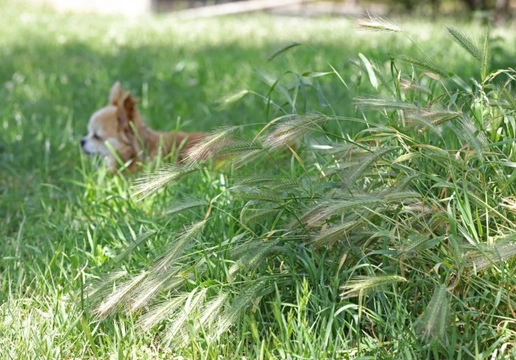
How meadow foxtail grass can pose a danger to dogs in summer
The rather innocuous-sounding meadow foxtail grass can actually be a big problem for dogs, and cause them irritations and injuries in a number of ways. This article will explain to dog owners how to recognise meadow foxtail grass, identify the sort of places it grows in, and outline why it is a problem to dogs in the first place. Read on to learn more.
What is meadow foxtail grass?
Meadow foxtail grass, also known as just “meadow foxtail” or simply “foxtail” is a type of tufted grass that will probably be immediately familiar to most people in the UK on sight, even if you did not know what it was called.
It is comprised of long, tube-shaped spikey heads (these are actually the flowers) on long grass stalks and this is known as meadow foxtail grass because the heads look somewhat like the tails of foxes.
Foxtail grass can grow up to a metre in height, and it stays green year-round. The head parts of the plant or the “foxtail” part itself can range from 2cm long up to 10cm, and they’re up to a centimetre wide.
Where and when does meadow foxtail grass grow in the UK?
Foxtails grow in both England and Wales year-round, and in some areas you might see them on your dog walks more or less daily. They tend to be more noticeable between April and June each year when the foxtail is flowering, and they’re most prolific as a whole from April to December.
The warmer months of the year too are those when dogs are most likely to come into contact with the grass, as they run through undergrowth and explore more freely.
Meadow foxtail grass can grow in fields and meadows (as the name implies) as well as along paths and in hedges. It needs fairly damp or moist soil to grow, but will not necessarily be found in boggy areas.
What makes meadow foxtail grass dangerous to dogs?
So, what’s the big deal here, and how come meadow foxtail grass can be a danger to dogs? It’s not poisonous per se (though you would not want your dog to eat it for the same reasons it is a problem externally) and the threat comes from the foxtail part itself.
The spiky strands or hairs of the foxtail are actually incredibly sharp, and this can result in them piercing your dog’s skin and even becoming embedded within their skin.
This is more of a threat on dogs with very thick and/or long coats, as foxtails tend to catch on or in the coat in the first instance. However, if it stays in the coat (as tends to happen with long and thick coats) it will tend to get tangled up and work its way deeper towards the skin, where the sharp ends of the foxtail can pierce the skin of the body.
On dogs of all types, including those with short or fine fur, foxtails can pierce or puncture the skin or cause issues in other areas of the body, each of which results in a complex problem of its own, which we will look at next.
Where to look for meadow foxtail grass problems on dogs
Grass seeds and sharp tines from grasses and plants of all types can be a problem in terms of your dog’s paws. They can work their way in or become lodged between the claw sheath and claw, between the toes, or between paw pad and skin.
This will be really painful and irritating for your dog, but might not have any visible sign of the foxtail if only the part under the skin remains in place.
Dogs can also inhale meadow foxtail grass heads by sniffing around in undergrowth, and they may lodge in place or break up in the nostril, which will all be hugely irritating and distressing and potentially painful for your dog.
Foxtails can end up lodged in your dog’s ear canals too, and this is perhaps a slightly higher risk for dogs with long, drooping ears and textured fur, like the springer spaniel and most other spaniel breeds. This is because this type of ear fur tends to catch the foxtail, which then works its way inside. However, the open ear canals of dogs with pointed or erect ears are at risk too.
Sharp spikes from foxtails can also end up in your dog’s eye, which will be very painful and irritating but once more, may not be visible to you.
It is worth noting that meadow foxtail grass can also pierce the general body skin, and in rare cases, even end up inside of the sheath of the genitalia of male dogs. Ingested or inhaled into the lungs, foxtails can be a big problem for dogs too.
You may not know that a foxtail is the issue in any of these scenarios as you may not be able to see it. However, you should take your dog to the vet for investigation if they’re displaying the sort of symptoms that may indicate a meadow foxtail problem, or if you’re otherwise unsure.
Learning to recognise what meadow foxtail grass looks like and trying to keep your dog away from it is wise too; as is checking over your dog’s skin, coat, and paws after every walk for foxtails or any other foreign body.



